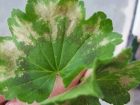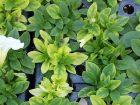
Features
Crop Culture
Inputs
Understanding The Language of Plants
Growers should pay closer attention to commonly grown bedding plants, and learn how to interpret their calls for attention when things are going wrong.
April 14, 2016 By Dr. Mohyuddin Mirza
Do plants have a language that we can learn to understand?
Of course only human beings are bestowed with the power to speak through languages, but plants have their own language. They cannot speak in English or other languages but they have a powerful way to express their feelings, deficiencies and stresses and strains. It is our job and duty to understand their stresses and strains so that we can help them stay healthy.
We all know that if plant problems are not diagnosed in time and proper remedial actions not taken, then economic losses can occur. In this first part of a series, I will show you how to understand the language of bedding plants.
Plants are very smart and have developed clever mechanisms to express themselves. The simple fact they carry out a number of functions to manufacture food is remarkable and they depend on growers to look after their needs.
EXAMPLE ONE: WHAT ARE THESE PLANTS TRYING TO TELL US
I took these pictures from a plug tray. One is from the middle of the tray (1A) and the other (1B) from the edge of the tray. What the plant is trying to tell us is, “I am sending roots where water is most available, where the temperature is not too cold, and where I have good oxygen available. My top growth is going to be affected the way you provide water to me. I like the conditions you are providing as shown in the picture on the left side.
“Did you know that I will make myself more vegetative when I am producing good roots all over and in the growing medium, and I will become more generative when you are keeping my growing medium drier. If you keep watering me with lesser amounts, then I will start producing flowers quicker than nearby plants.”
EXAMPLE #2: WHAT ARE THESE DRACAENAS TRYING TO COMMUNICATE?
In their own language, these plants are trying to communicate their feelings of frustration with the grower’s management practices. “You have choked my breath off by allowing this dark green algae to develop.
“In addition, these fungus gnats and shore flies are irritating me. They are here in droves and I trusted that you will look after my needs fully.
“But now you can clearly see my food manufacturing leaves are turning yellow and chlorotic and there are some dead spots on my skin. You are not able to sell me like this.
“You have been working with me since July of last year but now you are not even looking at me!”
So this is the kind of language these dracaena plants are trying to use. Due to this algae, oxygen supplies to the roots have been cut off and iron deficiency has occurred. Foliar feeding with iron chelate or sulphate alone is not going to help. My advice is to transplant these plants in bigger containers and start using products to control the algae.
EXAMPLE #3: DEALING WITH COLD TEMPERATURES
“I am a geranium plant. I was doing pretty well in this greenhouse. My owner knows me very well. He has grown members of my family for several years and I was always happy that he looked after me diligently. But one day he decided to move me from my house to a different house.
“Within few hours of this move I started shivering.
“I asked my cells what was going on. They told me they were in a shock because this new house was several degrees cooler than the house they grew up in as a baby.
“I don’t know why the water was so cold. I tried my best not to go into panic but could not control my feelings of shivering.
“Finally my cells sacrificed a few of their own to save other cells. The cells on the outer side decided to make this sacrifice. The ultimate price these cells paid is that they were cut off to save my young leaves.”
That is what the plant told me. So avoid sudden fluctuations in temperature when plants are moved from one greenhouse to another.
EXAMPLE #4: AVOIDING IRON DEFICIENCY
“I am a petunia plant and there are many of us in this tray. We were coming along pretty well and the grower was looking after our needs for watering, fertilizing, temperature control and other things.
“Slowly, I was feeling uncomfortable that something wrong was going on with my leaves.
“My cells reported that we were not able to make enough food needed to serve the needs of my roots, shoots and flowers, but I was not able to communicate that to the assistant grower who frequently came around to check on me.
“The grower did not know that I am an iron inefficient plant. It has been mentioned in workshops that I am a type of plant that changes the pH of my rootzone because I grow so fast. I need to get more OH ions out of my system so that I can absorb certain nutrients. You remember all that business about cations and anions!
“My grower should have checked the pH and I could have provided some clues to as what is going to happen soon. Unfortunately, it did not happen and now I am here stuck with iron deficiency, and iron is part of my food manufacturing business.
“This means I cannot make food efficiently and thus my plant health is being affected because the grower is not paying enough attention to me. I am worried that sales time is approaching and I will get a bad report as an iron-inefficient plant.”
I have found that if petunias have reached that stage of iron chlorosis, then foliar feeding alone is not going to help. Growers should focus on correcting the pH levels.
I am also finding that most commercial fertilizers have a wide range of iron added in their mixes and they report the contents at 200 ppm of nitrogen. Many times we have to feed less than 200 ppm of nitrogen to take into consideration nitrogen contribution from calcium nitrate.
We cannot understand the language of every bedding plant because we grow several hundred types of them and so such problems will keep appearing. My point is to create groups of plants, iron efficient and iron inefficient ones, and know where to focus. Frequently look at the roots. Make pH and EC observations at the first signs of anything unusable. Understand the role of temperature in plant growth and other factors.
Dr. Mohyuddin Mirza is an industry consultant. He can be contacted at drmirzaconsultants@gmail.com.
Print this page




